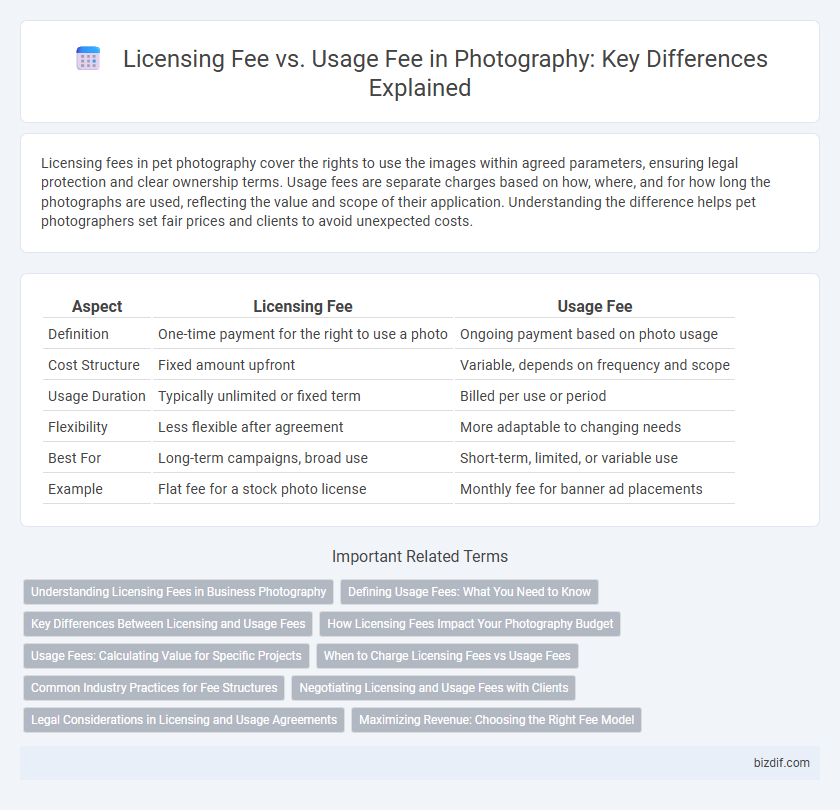Licensing fees in pet photography cover the rights to use the images within agreed parameters, ensuring legal protection and clear ownership terms. Usage fees are separate charges based on how, where, and for how long the photographs are used, reflecting the value and scope of their application. Understanding the difference helps pet photographers set fair prices and clients to avoid unexpected costs.
Table of Comparison
| Aspect | Licensing Fee | Usage Fee |
|---|---|---|
| Definition | One-time payment for the right to use a photo | Ongoing payment based on photo usage |
| Cost Structure | Fixed amount upfront | Variable, depends on frequency and scope |
| Usage Duration | Typically unlimited or fixed term | Billed per use or period |
| Flexibility | Less flexible after agreement | More adaptable to changing needs |
| Best For | Long-term campaigns, broad use | Short-term, limited, or variable use |
| Example | Flat fee for a stock photo license | Monthly fee for banner ad placements |
Understanding Licensing Fees in Business Photography
Licensing fees in business photography grant specific rights to use images within defined parameters such as duration, medium, and geographic area, ensuring legal protection and clarity for both photographer and client. Unlike usage fees, which vary based on how extensively and where the images are employed, licensing fees establish the foundational terms of use and dictate allowable applications to avoid unauthorized exploitation. Properly structured licensing fees enable photographers to monetize their work effectively while providing businesses with the flexibility to leverage images within agreed limits.
Defining Usage Fees: What You Need to Know
Usage fees in photography refer to the charges based on how, where, and for how long an image is used, differing from licensing fees that grant permission to use the photo. These fees vary depending on factors like media type, geographic distribution, audience size, and duration of use, ensuring appropriate compensation for the photographer's work. Understanding usage fees is essential for both clients and photographers to negotiate rights and avoid legal disputes.
Key Differences Between Licensing and Usage Fees
Licensing fees grant permission to use a photograph within specific terms, often covering a set duration, medium, and geographic region, whereas usage fees are calculated based on how extensively and frequently the image is used beyond the initial agreement. Licensing fees are typically a one-time payment for defined rights, while usage fees adjust according to factors such as the type of usage, audience size, and commercial scope. Understanding the distinction helps photographers and clients manage costs effectively and ensures compliance with intellectual property agreements.
How Licensing Fees Impact Your Photography Budget
Licensing fees directly affect your photography budget by determining the cost based on the scope and duration of image usage, often including exclusivity or territory rights. Higher licensing fees typically result from extended usage periods, larger distribution channels, or exclusive rights, significantly increasing overall expenses. Understanding and negotiating these fees helps photographers balance profitability while providing clients with tailored access to their work.
Usage Fees: Calculating Value for Specific Projects
Usage fees are determined by evaluating the specific parameters of a project, including the duration, distribution channels, and geographic reach of the intended use. Factors such as advertising platform, audience size, and exclusivity rights directly influence the calculation of usage fees. Accurate valuation ensures fair compensation by aligning fees with the scope and impact of a project's image utilization.
When to Charge Licensing Fees vs Usage Fees
Licensing fees are charged when granting permission for specific uses of a photograph, such as editorial, commercial, or digital distribution, based on the scope, duration, and territory of usage. Usage fees apply when the photo's application extends beyond the original license, including new formats, markets, or prolonged exposure, reflecting the added value and potential revenue. Photographers must clearly define licensing terms upfront and reassess fees when client usage changes to ensure fair compensation aligned with the image's use and reach.
Common Industry Practices for Fee Structures
Licensing fees in photography typically cover the right to use an image under specific conditions, often determined by factors such as duration, geographic region, and media type. Usage fees, on the other hand, reflect additional charges when the image is used beyond initial terms, including extended markets or platforms. Common industry practices involve setting a base licensing fee with scalable usage fees to ensure appropriate compensation for expanded use across advertising, editorial, and digital media.
Negotiating Licensing and Usage Fees with Clients
Negotiating licensing and usage fees with clients requires clear understanding of the scope, duration, and medium of image use to set appropriate pricing. Photographers should specify whether the fee covers exclusive or non-exclusive rights, geographic regions, and any potential extensions to avoid future disputes. Emphasizing transparent terms and tailored packages enhances client trust and ensures fair compensation for creative work.
Legal Considerations in Licensing and Usage Agreements
Licensing fees grant permission to use a photograph under specific terms, defining the scope, duration, and geographic region, while usage fees often relate to additional or extended uses beyond the original license agreement. Legal considerations in licensing and usage agreements must clearly outline rights, restrictions, indemnities, and payment structures to prevent unauthorized use and potential copyright infringement claims. Carefully drafted contracts protect photographers and clients by specifying permitted uses, exclusivity, and termination conditions aligned with intellectual property laws.
Maximizing Revenue: Choosing the Right Fee Model
Maximizing revenue in photography licensing involves selecting between a licensing fee and a usage fee based on the project's scope and client needs. Licensing fees provide a fixed, upfront payment granting permission to use the image under specified conditions, ensuring predictable income. Usage fees fluctuate with factors such as duration, geographic region, and media type, offering opportunities to increase earnings through extended or multi-platform usage.
Licensing Fee vs Usage Fee Infographic

 bizdif.com
bizdif.com